Medication Management: A Comprehensive Analysis of Viktor's COPD
VerifiedAdded on 2022/10/11
|8
|1855
|16
Practical Assignment
AI Summary
This assignment presents a case study of Viktor, a 63-year-old patient with chronic obstructive pulmonary disease (COPD) and a history of smoking, hypertension, and obstructive sleep apnea. The assignment analyzes Viktor's medical history, symptoms (including dyspnea and fatigue), and current medications, including Trelegy Ellipta, Augmentin Duo Forte, and home oxygen. It identifies problems such as poor medication adherence and the need for enhanced management. The assignment proposes strategies like drug inventory, motivational interviewing, and medication routine applications to improve Viktor's treatment plan. The expected outcomes include improved adherence, correct medication usage, and continuous obedience to the treatment plan. The reflection highlights the importance of understanding COPD's symptomatic burden and addressing medication compliance issues. The assignment also mentions relevant diagnostic tests and the clinical reasoning cycle.

Medication management
Name of the Student
Name of the University
Author Note
Name of the Student
Name of the University
Author Note
Paraphrase This Document
Need a fresh take? Get an instant paraphrase of this document with our AI Paraphraser
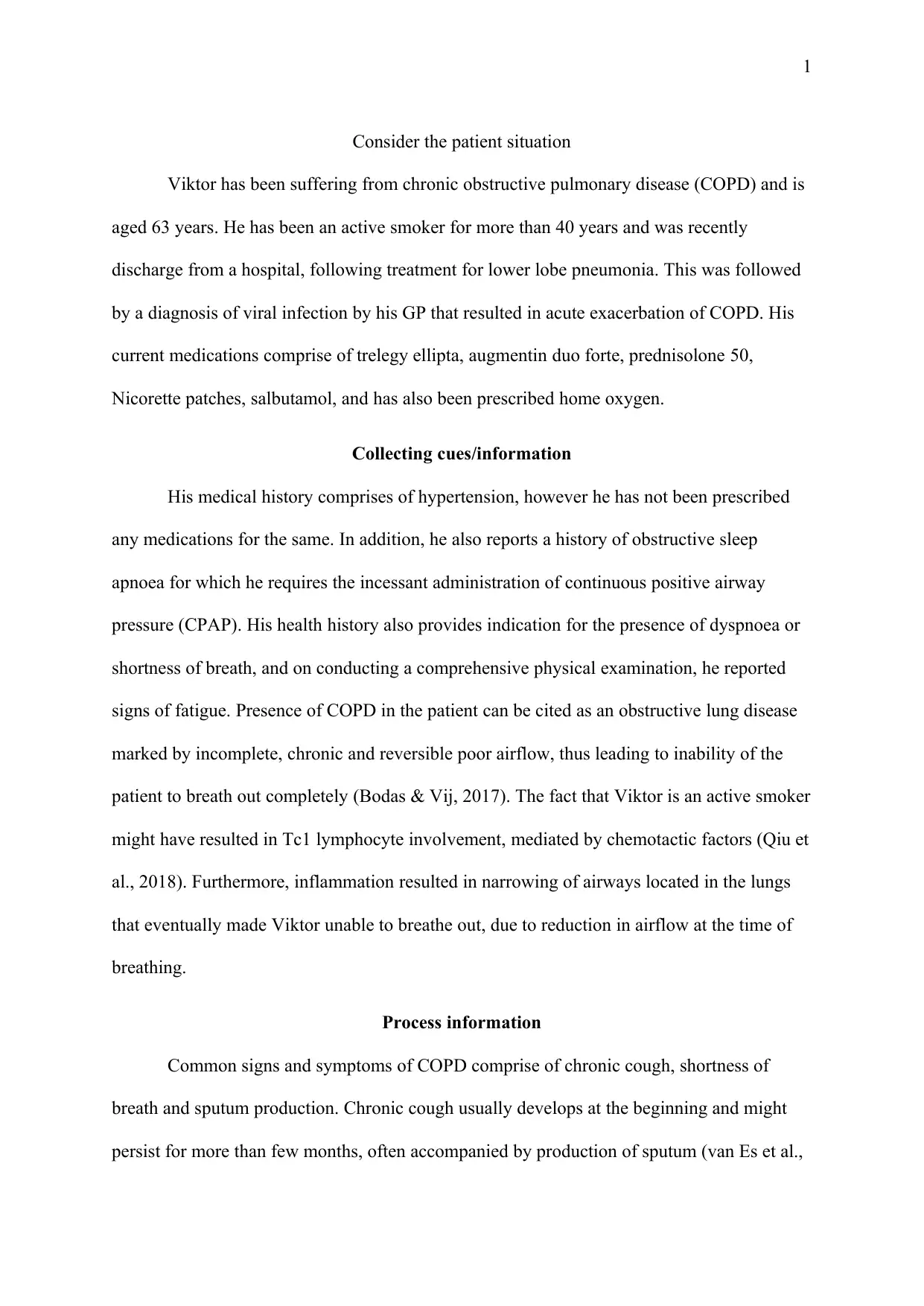
1
Consider the patient situation
Viktor has been suffering from chronic obstructive pulmonary disease (COPD) and is
aged 63 years. He has been an active smoker for more than 40 years and was recently
discharge from a hospital, following treatment for lower lobe pneumonia. This was followed
by a diagnosis of viral infection by his GP that resulted in acute exacerbation of COPD. His
current medications comprise of trelegy ellipta, augmentin duo forte, prednisolone 50,
Nicorette patches, salbutamol, and has also been prescribed home oxygen.
Collecting cues/information
His medical history comprises of hypertension, however he has not been prescribed
any medications for the same. In addition, he also reports a history of obstructive sleep
apnoea for which he requires the incessant administration of continuous positive airway
pressure (CPAP). His health history also provides indication for the presence of dyspnoea or
shortness of breath, and on conducting a comprehensive physical examination, he reported
signs of fatigue. Presence of COPD in the patient can be cited as an obstructive lung disease
marked by incomplete, chronic and reversible poor airflow, thus leading to inability of the
patient to breath out completely (Bodas & Vij, 2017). The fact that Viktor is an active smoker
might have resulted in Tc1 lymphocyte involvement, mediated by chemotactic factors (Qiu et
al., 2018). Furthermore, inflammation resulted in narrowing of airways located in the lungs
that eventually made Viktor unable to breathe out, due to reduction in airflow at the time of
breathing.
Process information
Common signs and symptoms of COPD comprise of chronic cough, shortness of
breath and sputum production. Chronic cough usually develops at the beginning and might
persist for more than few months, often accompanied by production of sputum (van Es et al.,
Consider the patient situation
Viktor has been suffering from chronic obstructive pulmonary disease (COPD) and is
aged 63 years. He has been an active smoker for more than 40 years and was recently
discharge from a hospital, following treatment for lower lobe pneumonia. This was followed
by a diagnosis of viral infection by his GP that resulted in acute exacerbation of COPD. His
current medications comprise of trelegy ellipta, augmentin duo forte, prednisolone 50,
Nicorette patches, salbutamol, and has also been prescribed home oxygen.
Collecting cues/information
His medical history comprises of hypertension, however he has not been prescribed
any medications for the same. In addition, he also reports a history of obstructive sleep
apnoea for which he requires the incessant administration of continuous positive airway
pressure (CPAP). His health history also provides indication for the presence of dyspnoea or
shortness of breath, and on conducting a comprehensive physical examination, he reported
signs of fatigue. Presence of COPD in the patient can be cited as an obstructive lung disease
marked by incomplete, chronic and reversible poor airflow, thus leading to inability of the
patient to breath out completely (Bodas & Vij, 2017). The fact that Viktor is an active smoker
might have resulted in Tc1 lymphocyte involvement, mediated by chemotactic factors (Qiu et
al., 2018). Furthermore, inflammation resulted in narrowing of airways located in the lungs
that eventually made Viktor unable to breathe out, due to reduction in airflow at the time of
breathing.
Process information
Common signs and symptoms of COPD comprise of chronic cough, shortness of
breath and sputum production. Chronic cough usually develops at the beginning and might
persist for more than few months, often accompanied by production of sputum (van Es et al.,
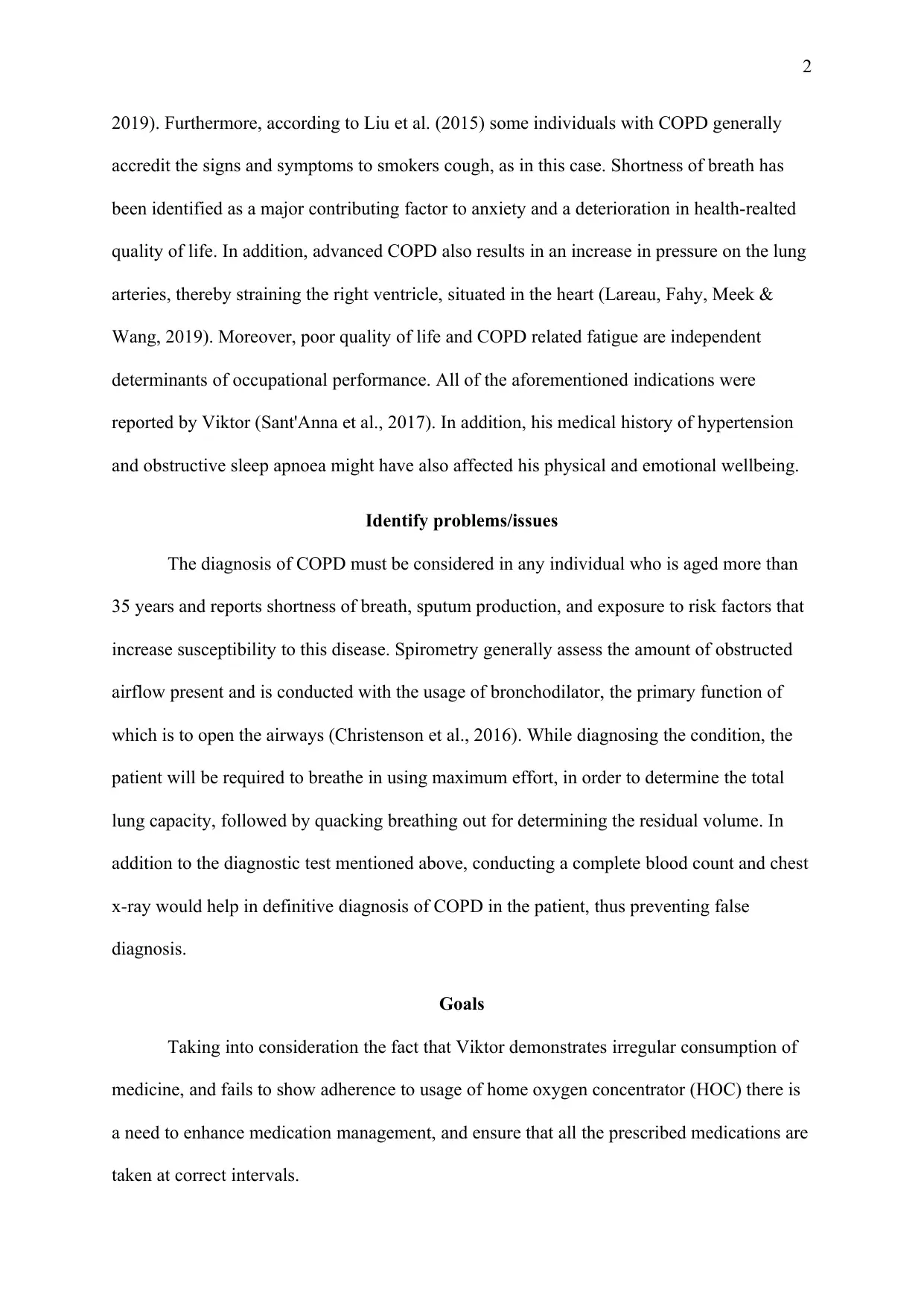
2
2019). Furthermore, according to Liu et al. (2015) some individuals with COPD generally
accredit the signs and symptoms to smokers cough, as in this case. Shortness of breath has
been identified as a major contributing factor to anxiety and a deterioration in health-realted
quality of life. In addition, advanced COPD also results in an increase in pressure on the lung
arteries, thereby straining the right ventricle, situated in the heart (Lareau, Fahy, Meek &
Wang, 2019). Moreover, poor quality of life and COPD related fatigue are independent
determinants of occupational performance. All of the aforementioned indications were
reported by Viktor (Sant'Anna et al., 2017). In addition, his medical history of hypertension
and obstructive sleep apnoea might have also affected his physical and emotional wellbeing.
Identify problems/issues
The diagnosis of COPD must be considered in any individual who is aged more than
35 years and reports shortness of breath, sputum production, and exposure to risk factors that
increase susceptibility to this disease. Spirometry generally assess the amount of obstructed
airflow present and is conducted with the usage of bronchodilator, the primary function of
which is to open the airways (Christenson et al., 2016). While diagnosing the condition, the
patient will be required to breathe in using maximum effort, in order to determine the total
lung capacity, followed by quacking breathing out for determining the residual volume. In
addition to the diagnostic test mentioned above, conducting a complete blood count and chest
x-ray would help in definitive diagnosis of COPD in the patient, thus preventing false
diagnosis.
Goals
Taking into consideration the fact that Viktor demonstrates irregular consumption of
medicine, and fails to show adherence to usage of home oxygen concentrator (HOC) there is
a need to enhance medication management, and ensure that all the prescribed medications are
taken at correct intervals.
2019). Furthermore, according to Liu et al. (2015) some individuals with COPD generally
accredit the signs and symptoms to smokers cough, as in this case. Shortness of breath has
been identified as a major contributing factor to anxiety and a deterioration in health-realted
quality of life. In addition, advanced COPD also results in an increase in pressure on the lung
arteries, thereby straining the right ventricle, situated in the heart (Lareau, Fahy, Meek &
Wang, 2019). Moreover, poor quality of life and COPD related fatigue are independent
determinants of occupational performance. All of the aforementioned indications were
reported by Viktor (Sant'Anna et al., 2017). In addition, his medical history of hypertension
and obstructive sleep apnoea might have also affected his physical and emotional wellbeing.
Identify problems/issues
The diagnosis of COPD must be considered in any individual who is aged more than
35 years and reports shortness of breath, sputum production, and exposure to risk factors that
increase susceptibility to this disease. Spirometry generally assess the amount of obstructed
airflow present and is conducted with the usage of bronchodilator, the primary function of
which is to open the airways (Christenson et al., 2016). While diagnosing the condition, the
patient will be required to breathe in using maximum effort, in order to determine the total
lung capacity, followed by quacking breathing out for determining the residual volume. In
addition to the diagnostic test mentioned above, conducting a complete blood count and chest
x-ray would help in definitive diagnosis of COPD in the patient, thus preventing false
diagnosis.
Goals
Taking into consideration the fact that Viktor demonstrates irregular consumption of
medicine, and fails to show adherence to usage of home oxygen concentrator (HOC) there is
a need to enhance medication management, and ensure that all the prescribed medications are
taken at correct intervals.
⊘ This is a preview!⊘
Do you want full access?
Subscribe today to unlock all pages.

Trusted by 1+ million students worldwide
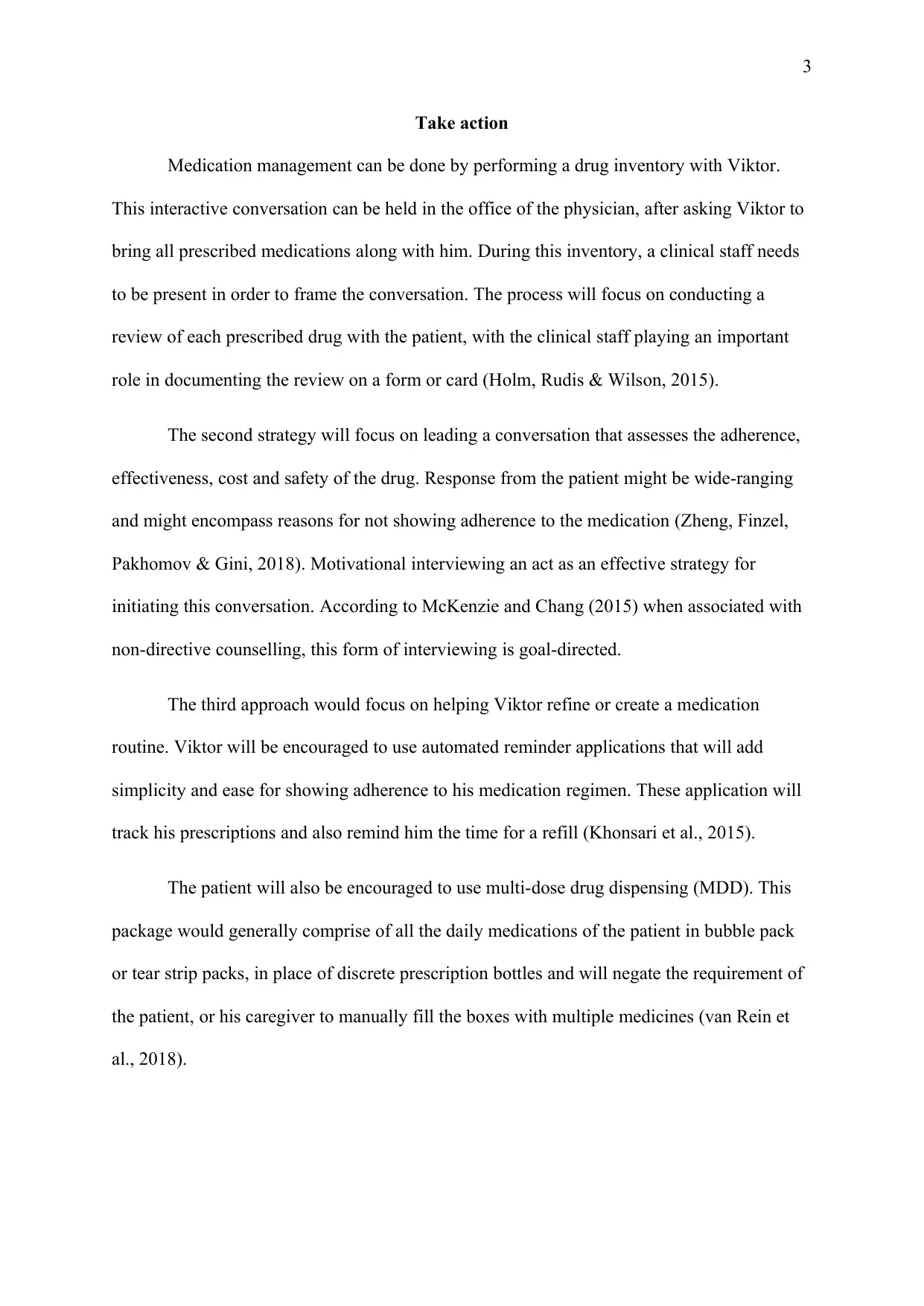
3
Take action
Medication management can be done by performing a drug inventory with Viktor.
This interactive conversation can be held in the office of the physician, after asking Viktor to
bring all prescribed medications along with him. During this inventory, a clinical staff needs
to be present in order to frame the conversation. The process will focus on conducting a
review of each prescribed drug with the patient, with the clinical staff playing an important
role in documenting the review on a form or card (Holm, Rudis & Wilson, 2015).
The second strategy will focus on leading a conversation that assesses the adherence,
effectiveness, cost and safety of the drug. Response from the patient might be wide-ranging
and might encompass reasons for not showing adherence to the medication (Zheng, Finzel,
Pakhomov & Gini, 2018). Motivational interviewing an act as an effective strategy for
initiating this conversation. According to McKenzie and Chang (2015) when associated with
non-directive counselling, this form of interviewing is goal-directed.
The third approach would focus on helping Viktor refine or create a medication
routine. Viktor will be encouraged to use automated reminder applications that will add
simplicity and ease for showing adherence to his medication regimen. These application will
track his prescriptions and also remind him the time for a refill (Khonsari et al., 2015).
The patient will also be encouraged to use multi-dose drug dispensing (MDD). This
package would generally comprise of all the daily medications of the patient in bubble pack
or tear strip packs, in place of discrete prescription bottles and will negate the requirement of
the patient, or his caregiver to manually fill the boxes with multiple medicines (van Rein et
al., 2018).
Take action
Medication management can be done by performing a drug inventory with Viktor.
This interactive conversation can be held in the office of the physician, after asking Viktor to
bring all prescribed medications along with him. During this inventory, a clinical staff needs
to be present in order to frame the conversation. The process will focus on conducting a
review of each prescribed drug with the patient, with the clinical staff playing an important
role in documenting the review on a form or card (Holm, Rudis & Wilson, 2015).
The second strategy will focus on leading a conversation that assesses the adherence,
effectiveness, cost and safety of the drug. Response from the patient might be wide-ranging
and might encompass reasons for not showing adherence to the medication (Zheng, Finzel,
Pakhomov & Gini, 2018). Motivational interviewing an act as an effective strategy for
initiating this conversation. According to McKenzie and Chang (2015) when associated with
non-directive counselling, this form of interviewing is goal-directed.
The third approach would focus on helping Viktor refine or create a medication
routine. Viktor will be encouraged to use automated reminder applications that will add
simplicity and ease for showing adherence to his medication regimen. These application will
track his prescriptions and also remind him the time for a refill (Khonsari et al., 2015).
The patient will also be encouraged to use multi-dose drug dispensing (MDD). This
package would generally comprise of all the daily medications of the patient in bubble pack
or tear strip packs, in place of discrete prescription bottles and will negate the requirement of
the patient, or his caregiver to manually fill the boxes with multiple medicines (van Rein et
al., 2018).
Paraphrase This Document
Need a fresh take? Get an instant paraphrase of this document with our AI Paraphraser
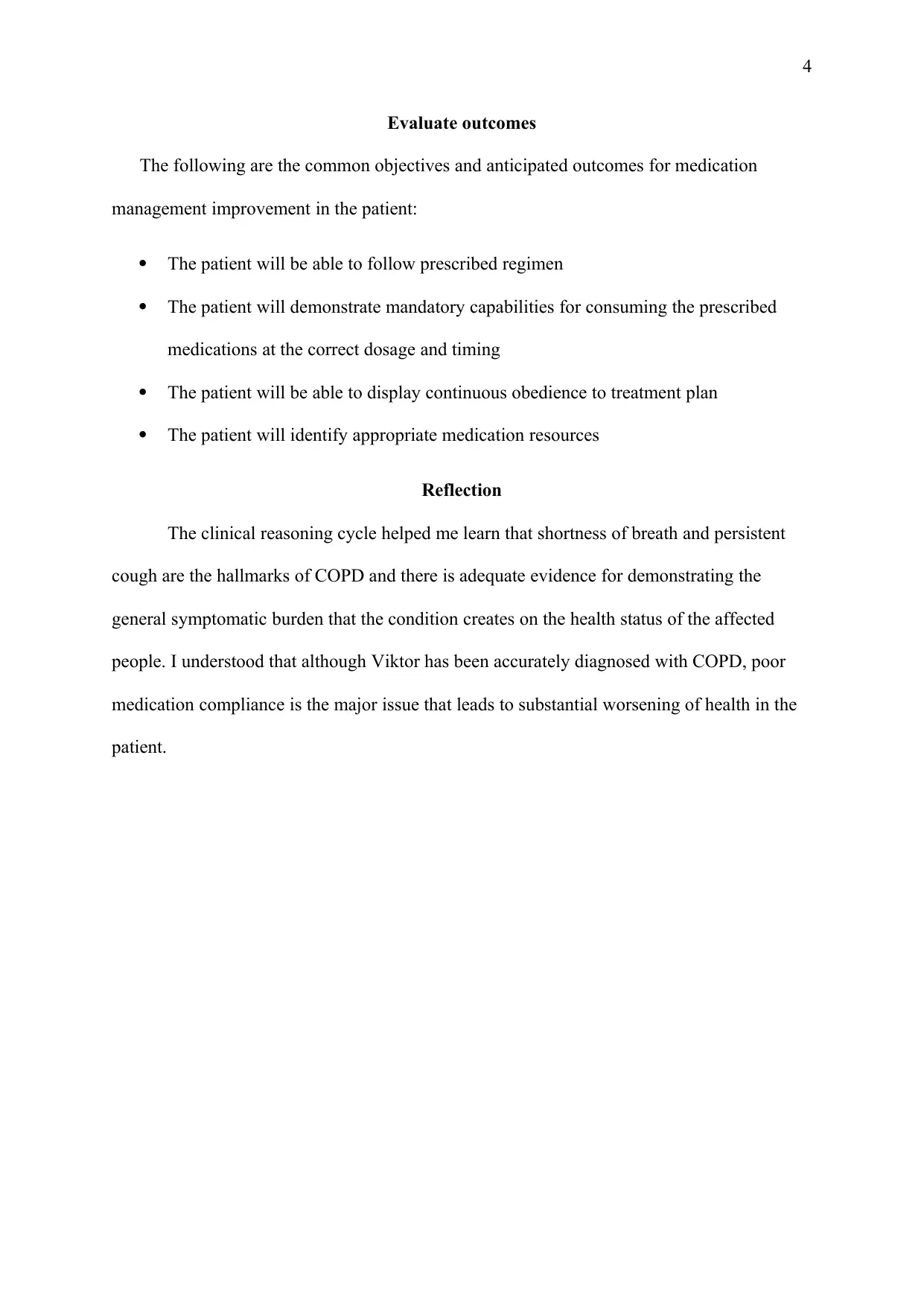
4
Evaluate outcomes
The following are the common objectives and anticipated outcomes for medication
management improvement in the patient:
The patient will be able to follow prescribed regimen
The patient will demonstrate mandatory capabilities for consuming the prescribed
medications at the correct dosage and timing
The patient will be able to display continuous obedience to treatment plan
The patient will identify appropriate medication resources
Reflection
The clinical reasoning cycle helped me learn that shortness of breath and persistent
cough are the hallmarks of COPD and there is adequate evidence for demonstrating the
general symptomatic burden that the condition creates on the health status of the affected
people. I understood that although Viktor has been accurately diagnosed with COPD, poor
medication compliance is the major issue that leads to substantial worsening of health in the
patient.
Evaluate outcomes
The following are the common objectives and anticipated outcomes for medication
management improvement in the patient:
The patient will be able to follow prescribed regimen
The patient will demonstrate mandatory capabilities for consuming the prescribed
medications at the correct dosage and timing
The patient will be able to display continuous obedience to treatment plan
The patient will identify appropriate medication resources
Reflection
The clinical reasoning cycle helped me learn that shortness of breath and persistent
cough are the hallmarks of COPD and there is adequate evidence for demonstrating the
general symptomatic burden that the condition creates on the health status of the affected
people. I understood that although Viktor has been accurately diagnosed with COPD, poor
medication compliance is the major issue that leads to substantial worsening of health in the
patient.
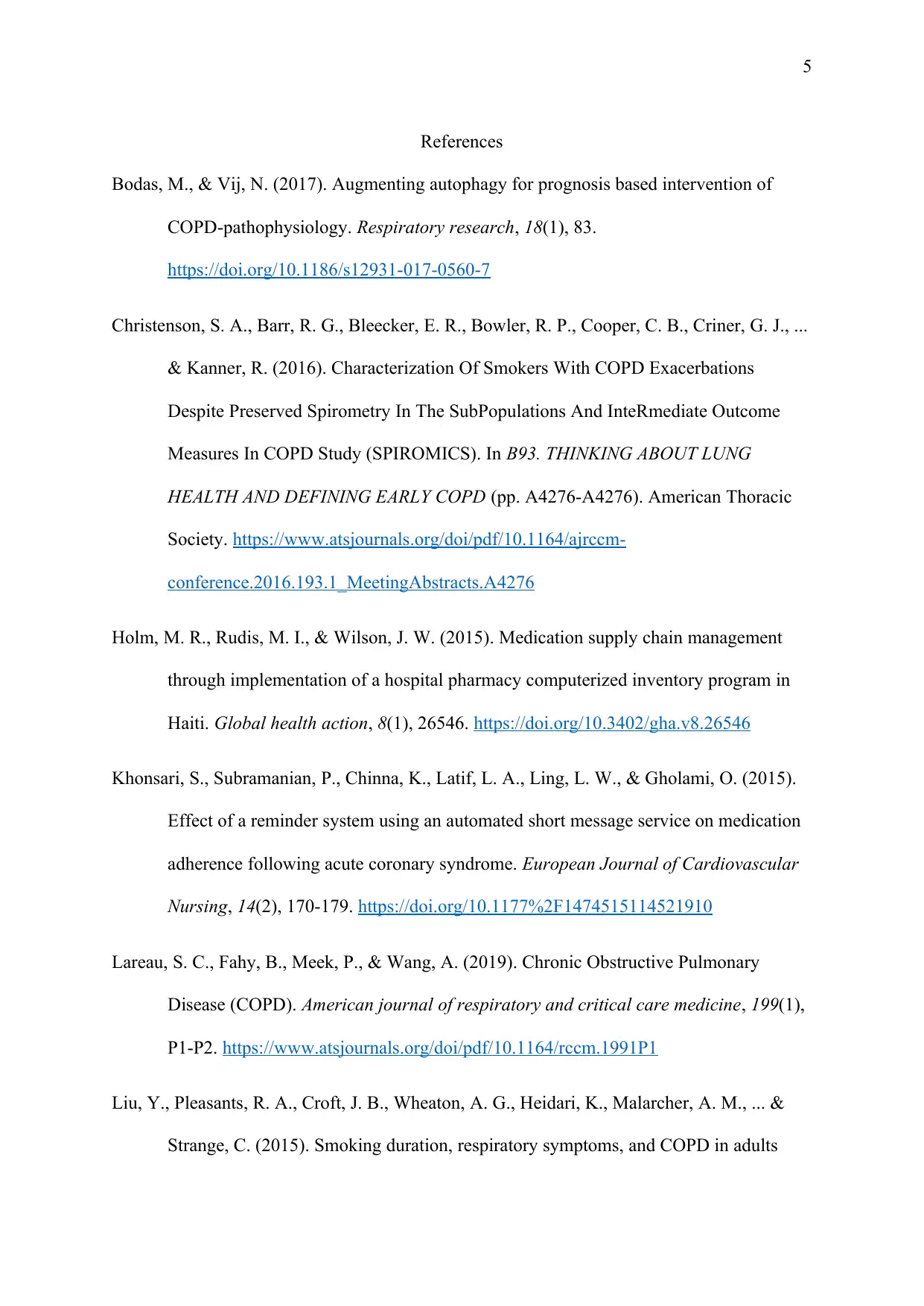
5
References
Bodas, M., & Vij, N. (2017). Augmenting autophagy for prognosis based intervention of
COPD-pathophysiology. Respiratory research, 18(1), 83.
https://doi.org/10.1186/s12931-017-0560-7
Christenson, S. A., Barr, R. G., Bleecker, E. R., Bowler, R. P., Cooper, C. B., Criner, G. J., ...
& Kanner, R. (2016). Characterization Of Smokers With COPD Exacerbations
Despite Preserved Spirometry In The SubPopulations And InteRmediate Outcome
Measures In COPD Study (SPIROMICS). In B93. THINKING ABOUT LUNG
HEALTH AND DEFINING EARLY COPD (pp. A4276-A4276). American Thoracic
Society. https://www.atsjournals.org/doi/pdf/10.1164/ajrccm-
conference.2016.193.1_MeetingAbstracts.A4276
Holm, M. R., Rudis, M. I., & Wilson, J. W. (2015). Medication supply chain management
through implementation of a hospital pharmacy computerized inventory program in
Haiti. Global health action, 8(1), 26546. https://doi.org/10.3402/gha.v8.26546
Khonsari, S., Subramanian, P., Chinna, K., Latif, L. A., Ling, L. W., & Gholami, O. (2015).
Effect of a reminder system using an automated short message service on medication
adherence following acute coronary syndrome. European Journal of Cardiovascular
Nursing, 14(2), 170-179. https://doi.org/10.1177%2F1474515114521910
Lareau, S. C., Fahy, B., Meek, P., & Wang, A. (2019). Chronic Obstructive Pulmonary
Disease (COPD). American journal of respiratory and critical care medicine, 199(1),
P1-P2. https://www.atsjournals.org/doi/pdf/10.1164/rccm.1991P1
Liu, Y., Pleasants, R. A., Croft, J. B., Wheaton, A. G., Heidari, K., Malarcher, A. M., ... &
Strange, C. (2015). Smoking duration, respiratory symptoms, and COPD in adults
References
Bodas, M., & Vij, N. (2017). Augmenting autophagy for prognosis based intervention of
COPD-pathophysiology. Respiratory research, 18(1), 83.
https://doi.org/10.1186/s12931-017-0560-7
Christenson, S. A., Barr, R. G., Bleecker, E. R., Bowler, R. P., Cooper, C. B., Criner, G. J., ...
& Kanner, R. (2016). Characterization Of Smokers With COPD Exacerbations
Despite Preserved Spirometry In The SubPopulations And InteRmediate Outcome
Measures In COPD Study (SPIROMICS). In B93. THINKING ABOUT LUNG
HEALTH AND DEFINING EARLY COPD (pp. A4276-A4276). American Thoracic
Society. https://www.atsjournals.org/doi/pdf/10.1164/ajrccm-
conference.2016.193.1_MeetingAbstracts.A4276
Holm, M. R., Rudis, M. I., & Wilson, J. W. (2015). Medication supply chain management
through implementation of a hospital pharmacy computerized inventory program in
Haiti. Global health action, 8(1), 26546. https://doi.org/10.3402/gha.v8.26546
Khonsari, S., Subramanian, P., Chinna, K., Latif, L. A., Ling, L. W., & Gholami, O. (2015).
Effect of a reminder system using an automated short message service on medication
adherence following acute coronary syndrome. European Journal of Cardiovascular
Nursing, 14(2), 170-179. https://doi.org/10.1177%2F1474515114521910
Lareau, S. C., Fahy, B., Meek, P., & Wang, A. (2019). Chronic Obstructive Pulmonary
Disease (COPD). American journal of respiratory and critical care medicine, 199(1),
P1-P2. https://www.atsjournals.org/doi/pdf/10.1164/rccm.1991P1
Liu, Y., Pleasants, R. A., Croft, J. B., Wheaton, A. G., Heidari, K., Malarcher, A. M., ... &
Strange, C. (2015). Smoking duration, respiratory symptoms, and COPD in adults
⊘ This is a preview!⊘
Do you want full access?
Subscribe today to unlock all pages.

Trusted by 1+ million students worldwide
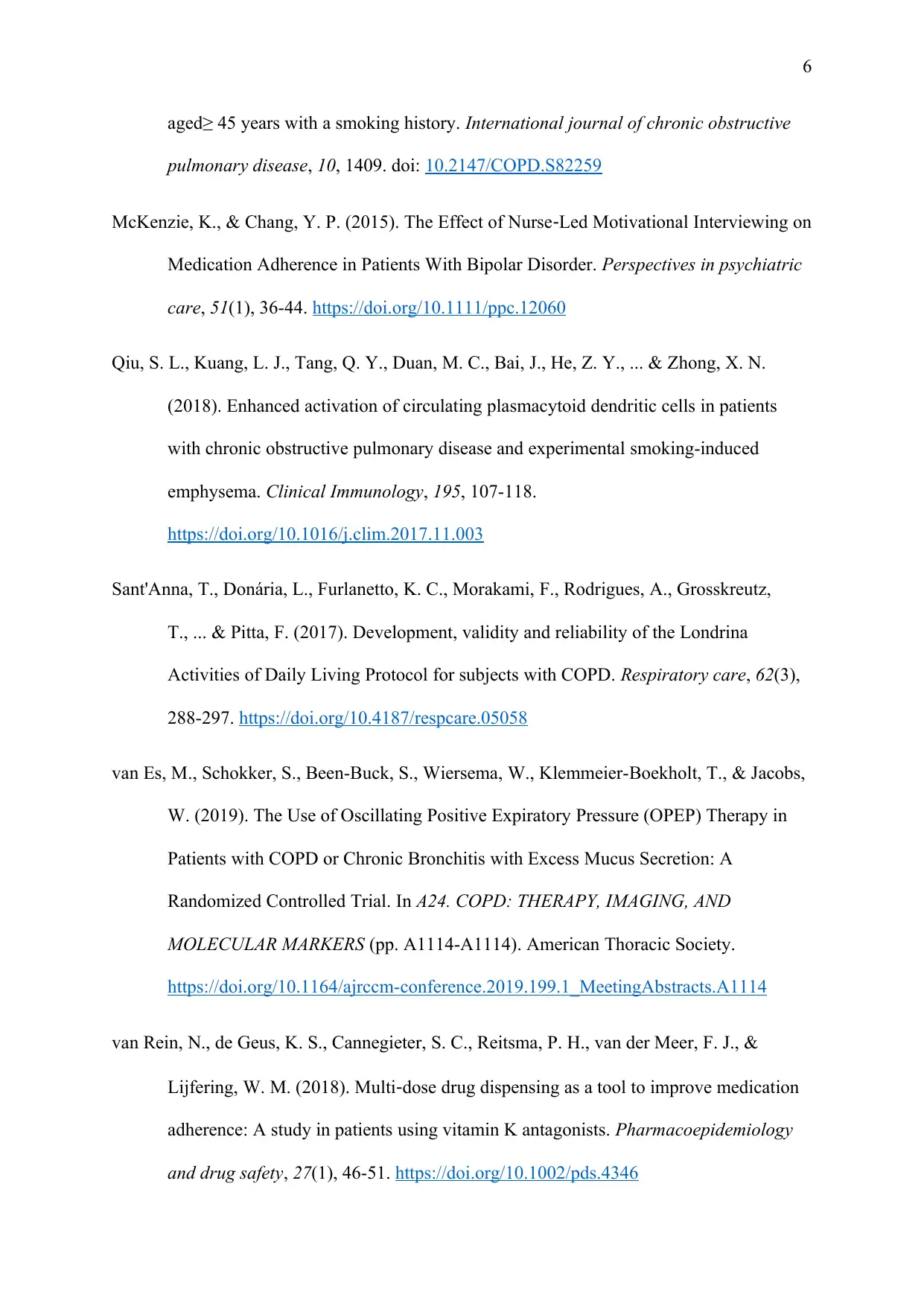
6
aged≥ 45 years with a smoking history. International journal of chronic obstructive
pulmonary disease, 10, 1409. doi: 10.2147/COPD.S82259
McKenzie, K., & Chang, Y. P. (2015). The Effect of Nurse‐Led Motivational Interviewing on
Medication Adherence in Patients With Bipolar Disorder. Perspectives in psychiatric
care, 51(1), 36-44. https://doi.org/10.1111/ppc.12060
Qiu, S. L., Kuang, L. J., Tang, Q. Y., Duan, M. C., Bai, J., He, Z. Y., ... & Zhong, X. N.
(2018). Enhanced activation of circulating plasmacytoid dendritic cells in patients
with chronic obstructive pulmonary disease and experimental smoking-induced
emphysema. Clinical Immunology, 195, 107-118.
https://doi.org/10.1016/j.clim.2017.11.003
Sant'Anna, T., Donária, L., Furlanetto, K. C., Morakami, F., Rodrigues, A., Grosskreutz,
T., ... & Pitta, F. (2017). Development, validity and reliability of the Londrina
Activities of Daily Living Protocol for subjects with COPD. Respiratory care, 62(3),
288-297. https://doi.org/10.4187/respcare.05058
van Es, M., Schokker, S., Been-Buck, S., Wiersema, W., Klemmeier-Boekholt, T., & Jacobs,
W. (2019). The Use of Oscillating Positive Expiratory Pressure (OPEP) Therapy in
Patients with COPD or Chronic Bronchitis with Excess Mucus Secretion: A
Randomized Controlled Trial. In A24. COPD: THERAPY, IMAGING, AND
MOLECULAR MARKERS (pp. A1114-A1114). American Thoracic Society.
https://doi.org/10.1164/ajrccm-conference.2019.199.1_MeetingAbstracts.A1114
van Rein, N., de Geus, K. S., Cannegieter, S. C., Reitsma, P. H., van der Meer, F. J., &
Lijfering, W. M. (2018). Multi‐dose drug dispensing as a tool to improve medication
adherence: A study in patients using vitamin K antagonists. Pharmacoepidemiology
and drug safety, 27(1), 46-51. https://doi.org/10.1002/pds.4346
aged≥ 45 years with a smoking history. International journal of chronic obstructive
pulmonary disease, 10, 1409. doi: 10.2147/COPD.S82259
McKenzie, K., & Chang, Y. P. (2015). The Effect of Nurse‐Led Motivational Interviewing on
Medication Adherence in Patients With Bipolar Disorder. Perspectives in psychiatric
care, 51(1), 36-44. https://doi.org/10.1111/ppc.12060
Qiu, S. L., Kuang, L. J., Tang, Q. Y., Duan, M. C., Bai, J., He, Z. Y., ... & Zhong, X. N.
(2018). Enhanced activation of circulating plasmacytoid dendritic cells in patients
with chronic obstructive pulmonary disease and experimental smoking-induced
emphysema. Clinical Immunology, 195, 107-118.
https://doi.org/10.1016/j.clim.2017.11.003
Sant'Anna, T., Donária, L., Furlanetto, K. C., Morakami, F., Rodrigues, A., Grosskreutz,
T., ... & Pitta, F. (2017). Development, validity and reliability of the Londrina
Activities of Daily Living Protocol for subjects with COPD. Respiratory care, 62(3),
288-297. https://doi.org/10.4187/respcare.05058
van Es, M., Schokker, S., Been-Buck, S., Wiersema, W., Klemmeier-Boekholt, T., & Jacobs,
W. (2019). The Use of Oscillating Positive Expiratory Pressure (OPEP) Therapy in
Patients with COPD or Chronic Bronchitis with Excess Mucus Secretion: A
Randomized Controlled Trial. In A24. COPD: THERAPY, IMAGING, AND
MOLECULAR MARKERS (pp. A1114-A1114). American Thoracic Society.
https://doi.org/10.1164/ajrccm-conference.2019.199.1_MeetingAbstracts.A1114
van Rein, N., de Geus, K. S., Cannegieter, S. C., Reitsma, P. H., van der Meer, F. J., &
Lijfering, W. M. (2018). Multi‐dose drug dispensing as a tool to improve medication
adherence: A study in patients using vitamin K antagonists. Pharmacoepidemiology
and drug safety, 27(1), 46-51. https://doi.org/10.1002/pds.4346
Paraphrase This Document
Need a fresh take? Get an instant paraphrase of this document with our AI Paraphraser

7
Zheng, J., Finzel, R., Pakhomov, S., & Gini, M. (2018). Spoken Dialogue Systems for
Medication Management. W3PHIAI 2019.
https://www-users.cs.umn.edu/~gini/papers/zheng-w3phiai-19.pdf
Zheng, J., Finzel, R., Pakhomov, S., & Gini, M. (2018). Spoken Dialogue Systems for
Medication Management. W3PHIAI 2019.
https://www-users.cs.umn.edu/~gini/papers/zheng-w3phiai-19.pdf
1 out of 8
Related Documents
Your All-in-One AI-Powered Toolkit for Academic Success.
+13062052269
info@desklib.com
Available 24*7 on WhatsApp / Email
![[object Object]](/_next/static/media/star-bottom.7253800d.svg)
Unlock your academic potential
Copyright © 2020–2025 A2Z Services. All Rights Reserved. Developed and managed by ZUCOL.





